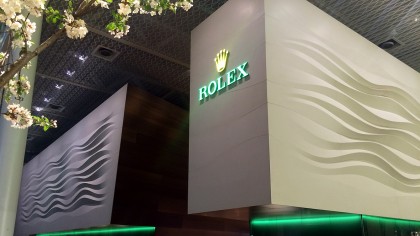What we learned about the future of smartwatches at the world's biggest watch show
When Silicon Valley meets Switzerland… The world will quake! (Or not)

As that meteorite hurtled towards the earth, the dinosaurs partied on, oblivious.
"Look at us, we're massive! Mammals will never catch on, they're ugly and hairy. We've been here for millions of years and… Ooh, hasn't it gone dark suddenly?" (Bang.)
Baselworld in Switzerland is the world's number one watch show. Its inhabitants are the dinosaurs, the Apple Watch is the meteorite and smartwatches (and wrist-worn wearables in general) are the mammals. Its a torturous analogy, and an exaggerated one, but my English teacher always said to start with a grabby sentence.
Anyway, we just spent two days living it up at Baselworld - and boy do those old, rich, Swiss guys know how to party - and we learned some things. Here is the main one.

1. Almost nobody who makes the high-end watches that dominate the show gives a hoot about smartwatches.
In terms of organisation, opulence and the rich, strong smell of money, Baselworld - and in particular its three-storey main hall - is head and shoulders above any tech event. All the 50 or so big brands' "stands" are multi-tiered, exquisitely-designed pavilions humming with suited staff, elegant receptionists and helpers, and visited by a steady stream of journalists, buyers and advertisers.
What they all had in common, from Rolex to G-Shock, is that none of them can quite see a compelling use or a way to make money out of smartwatches. They don't think customers really want it. They actually, visibly wince when contemplating the horror of having to charge up a watch daily. Then they say, "We're sponsoring some more yachts this year. Have you met our brand ambassador Felix Baumgartner? He sky-dived from space. Would you like some more Champagne and cheese?"
Fact is, in the entire main hall, there was nothing you could really describe as a smartwatch. Although there were some quite interesting semi-smarties that we'll come to later.
Sign up for breaking news, reviews, opinion, top tech deals, and more.

2. One man who makes high-end watches DOES give a hoot about smartwatches.
That slightly stopped figure in a stylishly rumpled suit (stylishly rumpled for about 1987, anyway) is Jean-Claude Biver. He's on Tag Heuer's board and has worked at the top level in the watch biz for many years, for Omega, Hublot and Blancpain.
Biver has an air of eccentricity about him, but he is not a dinosaur. He's plunged Tag Heuer into competition with Apple, Samsung, LG and the rest, and he's going in fully armed. There's no pissing about with fitness-track dabbling or message alerts via lights and sounds here. Tag is making an Android Wear watch, in collaboration with Google (obviously) and Intel.
Biver's since dropped hints that it'll retail for around $1,000 and be round.
I must admit, I initially assumed it'd follow the brand's squared off, Monaco form factor (as worn by Steve McQueen) but the reference point is, supposedly, the Carrera – according to Hodinkee.com, Biver bellowed, ""For $1,000 would you rather wear the Apple Watch, or a watch that looks like this Carrera?" – and that's round.
In point of fact, Tag Heuer is noted for its forward-looking approach. It sponsors Formula E, which many of the Formula 1 fans who Tag sell to see as a kind of heresy. Now it's making a smartwatch, which many of its punters probably see in much the same way, only more so. But really, a smartwatch is a continuation for this brand, not a left turn.
Now, another thing about the Carrera this piece will supposedly be based on is that it's a skeleton watch – you can see its inner workings. That would be impossible with a touchscreen; it'll just be another Android Wear, electronic watch but in a fancier case. Right? No sir: wrong!